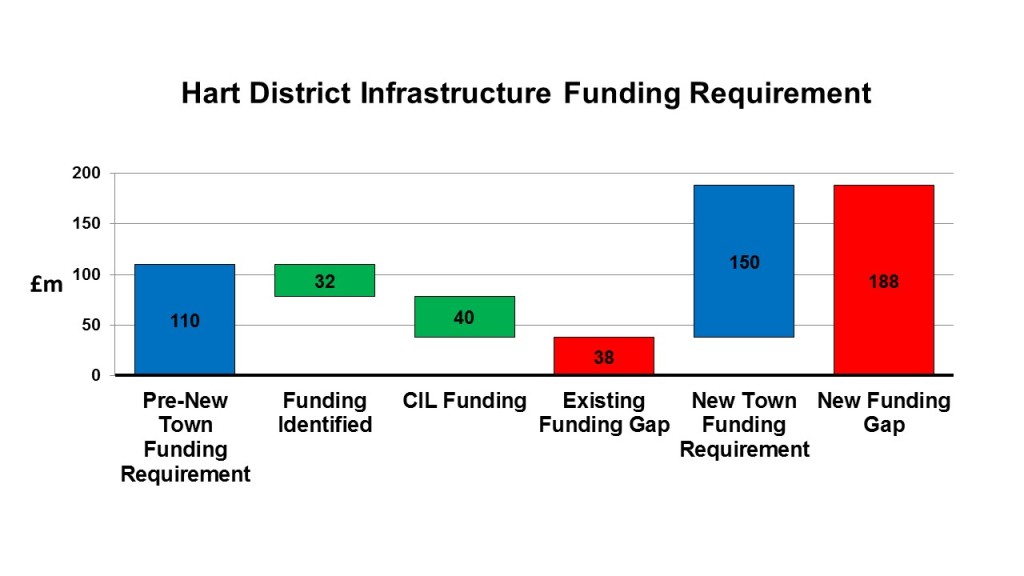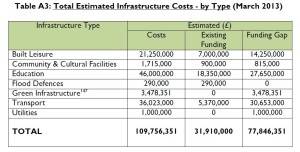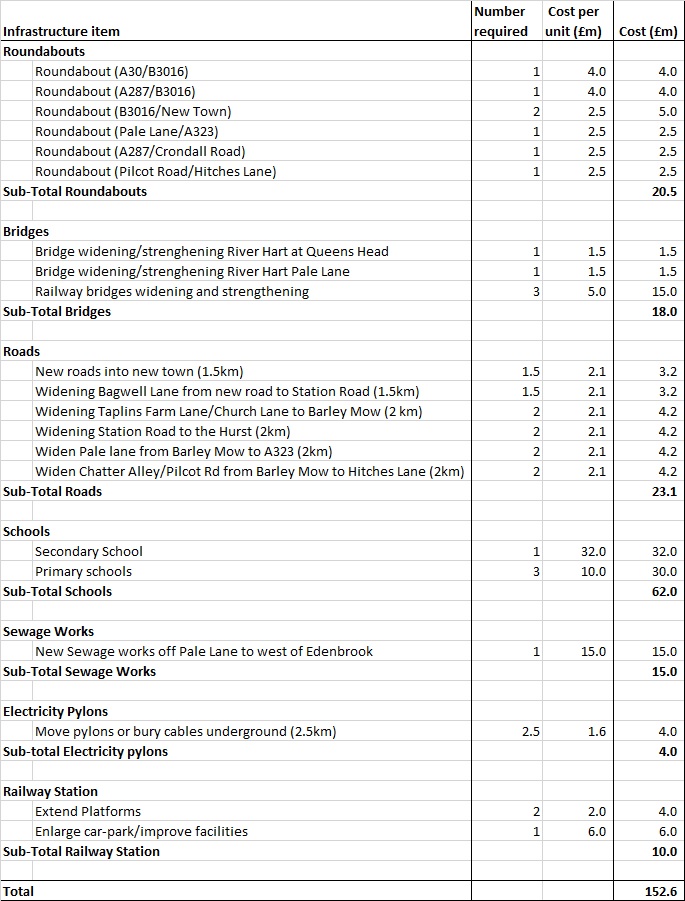There is a potential infrastructure funding gap of up to £188m arising from the plan for a new town in Hart District. Much has been made of the infrastructure benefits that could be brought to the district by building a new town, however, it is not widely known that there is already a £78m funding gap for infrastructure. This does not include the infrastructure costs of a new town, nor the expected funding from a developer. We might expect Community Infrastructure Levy (CIL) funding – or S106 – to yield £40m from the developer, but the infrastructure costs of a new town could be up to £150m (not including costs of improving healthcare services), meaning that if Hart were to proceed with this plan, we would have a funding gap of £188m. Note that new analysis from Hart District Council indicates that costs could increase to over £300m.
This surely leaves the idea of a new town in tatters. Indeed it calls into question the whole idea of building an extra 7,500 homes in Hart, wherever they are built because there simply isn’t enough money to fund road improvements, new schools, new healthcare facilities or improvements to railway stations. One has to ask why the council are pushing through this idea when the costs are outrageous, the funding isn’t available and the results will be devastating for the local area?
If you would like the Government and Hart to think again, please sign the We Heart Hart (aka We ♥ Hart and We Love Hart) petition.
Of course the £150m cost of infrastructure for the new town is my estimate, but it is clear whatever the actual number there is a considerable gap to be closed between the cost of the infrastructure required for the Local Plan and the funding available.
The detail of the calculations to back up these numbers is shown below.
First, here is the table from the Hart Infrastructure Delivery Schedule:
This shows that there is an existing gap of £78m. Some say that even this is an under-estimate. Crucially it does not include any infrastructure for the proposed new town: no new schools, no road improvements in that area and no improvements to the railways. And it does not attribute a cost to healthcare improvements like doctors surgeries or expansion of hospitals.
We might expect around £40m from developing 4,000 new houses that have not yet received planning permission in the local plan. This is based on only 2,400 houses being eligible for a CIL charge as 40% of what is built has to be “affordable” and does not attract a CIL charge. If each house is 95 sq m, and the charge per sq m is £175, then this results in CIL funding of £40m. If they use S106 instead of CIL, the yield can be expected to be broadly similar.
Note that CIL money has to be used for specific projects outlined in the Regulation 123 list. None of the projects on this list relate to building a new town. So all of that money raised will have to towards funding the existing gap. This leaves a gap of £38m before even considering the costs of infrastructure for the new town in Winchfield or anywhere else.
A back of the envelope calculation suggests that the proposed Hart new town will need around £150m of spending on infrastructure.
Of course, the road widening costs above will mean the destruction of miles of ancient hedgerow which is highly undesirable. Many of the other works would be very detrimental to the environment and the rural feel of Hart.
The sources for these number are as follows:
- Roundabouts. Cost of A30 improvements at Blackbushe is around £4m. Roundabouts at either end of the B3016 will cross a dual carriageway and will likely require some element of approach road improvement, so reasonable to assume the cost of each change will be about the same. I have scaled down this number for the additional roundabouts needed as they are simpler.
- Bridge improvements estimated. Both bridges over the river Hart (at the Queens Head pub and on Pale Lane) will need to be completely replaced and widened to cope with two way traffic and probably some road adjustments too. The work on the railway bridges will be considerable to widen them to cater for two way traffic underneath, and potentially to strengthen them for double decker trains. Plus the Barratts new town plan for Winchfield shows a new footbridge over the motorway that hasn’t been individually costed.
- Road costs estimated from this 2006 report from Imperial College London give a cost of £2.13m/km of new single carriageway road. Road lengths above taken from Google Maps.
- Schools. Hart Council quoted £32m as the cost of a secondary school. Scaled this down to £10m for cost of new primary school. Note that the secondary school is within a couple of hundred metres of the M3 and one of the primary schools is located between the M3 and the railway, hardly a suitable environment for children to grow up in.
- Sewage Works. The cost of water treatment works varies considerably. For example a new works at Newton-on-Trent to serve part of Lincoln cost £45m and an upgrade to the Mogden works cost £145m. So, I’ve gone for a conservative £15m, which may well be an under-estimate.
- Electricity Pylons. No-one is going to want to live underneath high voltage electricity pylons, and two lots of high voltage pylons cross the planned area for the new town. Presumably they were put there originally because they weren’t near where people live. It costs £1.6m/km to lay new pylon runs and £20m/km to bury cables. For the purposes of this I have assumed that it costs a similar amount per km to move existing pylons. If they have to bury them, then that will cost £50m on its own.
- Railway Station. It cost £6m to upgrade the facilities and car-park at Fleet, and similar works would be required at Winchfield. It also cost £4m to extend the platforms at Bedford station, and similar works will be needed at Winchfield because it can only cope with 8-car trains at the moment.
Please download a poster: https://wehearthart.co.uk/home/get-involved/
Sign the petition: https://you.38degrees.org.uk/petitions/we-hart
Like us on Facebook: https://www.facebook.com/groups/IHeartHart/
Follow us on Twitter: https://twitter.com/WeHeartHart



Pingback: Hart District Council persists with Winchfield New Town idea despite petition from 2,130 people
Pingback: Infrastructure costs of over £300m put Winchfield new town plans in doubt | We Heart Hart
Pingback: A30 roundabout cost escalation casts doubt on Winchfield new town infrastructure plans | We Heart Hart
Pingback: Where does your Hart District Council candidate stand on a new town? | We Heart Hart
Pingback: How to make a better Local Plan for Hart District | We Heart Hart
Pingback: We Heart Hart petition is now twice as big as Hart District Council consultation | We Heart Hart
Pingback: Hart District Council in disarray over infrastructure costs and funding | We Heart Hart
I’m not sure the argument about the location of the schools is particularly strong. Elvetham Heath Primary is located 450m from the M3 (the main carriageway, not the services) and 350m from the railway, and it’s generally considered to be a very good school.
Well apparently living near motorways is bad for children’s lungs, so presumably going to school near one is bad too:
http://www.theguardian.com/environment/2007/jan/26/pollution.transportintheuk
I guess going to school next to one and living next to one is even worse.
I am glad Elvetham is a good school
Er, don’t Network Rail look after the platform and car park, not Hart? And should Hart be responsible for paying for pylons to be moved?
Lot of assumptions made here which, if wrong, undermine your efforts.
The infrastructure delivery schedule shows all of the infrastructure and the overall funding which comes from a variety of sources, not just Hart. There is currently a £78m funding gap. There is about £40m to come from CIL/S106 to help close that gap to £38m, but there is a lot of additional infrastructure required for the new town which is currently not funded. This might be £150m, or it might be more or it might be less. Regardless each and every pound required increases the gap from £38m
I don’t know who has to fund the moving the pylons. Probably the developer. But they will then argue that they can’t afford to make other infrastructure payments because to do so will make the development uneconomic. So, then someone else has to pick up everything else.
What is most likely to happen unless we do something about it, is the houses get built, but the infrastructure doesn’t.
As I understand it form here: http://www.fleetsteam.co.uk/id20.html Hampshire County Council (strapped for cash) funded almost all of the Fleet station improvement. They have no current plans, nor money, nor is it in the schedule to improve Winchfield or Hook.
I simply don’t understand how it is rational and reasonable for the council to foot part of the bill for a new development so as to make it economical for the developer. If the development is not economical, it is unreasonable (from the public perspective) to expect the council to fund part of the work (for example, moving the pylons) just so the developer can make their profit. If a developer wants to develop a parcel of land then they should be expected to meet 100% of the cost themselves. And, furthermore, it should be a requirement that all of the infrastructure work is completed to the council’s satisfaction before building can begin on any of the houses – this would prevent the situation where developers promise infrastructure and then never deliver it.
I guess the other side of the equation is that developers need to make money in order to survive as businesses. I am not sure who would have to foot the bill for moving the pylons. It may be the developer. But even if that is so, they will argue that because they have to fund that, then they can’t afford to fund other infrastructure items.
Of course, they could pay less for the land in the first place, to give more headroom for funding infrastructure. But that would then mean that landowners get less money and they might sell less land.
Overall, it is a bit of a mess. And lord knows why they ended up with such a large current funding gap even without the new town.